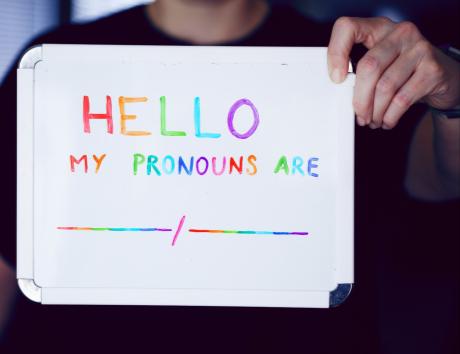The best way to include pronouns on resume: A helpful guide
Everyone wants to feel welcome and included in the workplace, especially marginalized individuals such as transgender people and those who use nontraditional pronouns. Putting pronouns on resumes can help applicants walk into the interview room with confidence, knowing that the hiring team already understands their identity. Here’s how to tactfully put your pronouns and preferred name on resumes.

Choosing the right name for your resume
Your resume should aim to make a strong first impression on potential employers while sharing a bit about who you are. The name you choose to put on your resume and cover letter should represent your identity, whether it’s your name, a gender-neutral identifier, or even just an initial.
You can use a preferred name on your resume that differs from your legal name. Many job seekers do this in order to present themselves more authentically and to feel more comfortable.
However, it’s important to be prepared to explain the variance and provide legal documentation when necessary. You will likely need to use your legal name during the later stages of the hiring process. For example, you should provide your legal name on any background check forms and insurance documents.
While forward-thinking employers will respect your identity, they must still follow state and federal laws regarding insurance, tax deductions, and work eligibility verification. They will need an official form of identification, such as a state-issued driver’s license or ID card. The name on your background check and W-2 tax forms must match what’s on your ID.
Feel free to use your preferred pronouns and name on all other documents. If you do not want to use a traditionally masculine or feminine name, consider choosing a gender-neutral name or simply using an initial. For example, “Jordan” or “J.” can be effective ways to avoid gender-specific assumptions. This approach allows you to present yourself in a way that aligns with your identity while minimizing biases.
How to include pronouns on a resume
Adding your pronouns to your resume and cover letter communicates your gender identity to potential employers. It also helps set the tone for how you expect to be addressed, reducing the chances of misgendering during interviews and other communications. There are a few different ways to include pronouns on resumes.
One common practice involves listing your pronouns on a separate line directly below your name. For example:
Jordan Smith
They/Them
The placement clearly conveys the applicant’s preferred pronouns.
Another option involves incorporating your pronouns within your summary or objective statement. If you use this approach, consider adding your preferred pronouns at the end of the last sentence in your summary:
“Experienced administrative assistant seeking a new challenge with opportunities for growth (he/him).”
Whichever method you choose, it’s crucial to use the same pronouns consistently throughout your resume and cover letter. Consistency not only reinforces your identity but also enables potential employers to respect your preferences in all written and verbal communications.
The bottom line is that you should use your pronouns relatively early in your documents. You want them to be easy to spot without appearing forced into the document without purpose.
Still not quite sure where to place your pronouns? Use our resume examples as a guide.
Formatting and placement considerations
Now, let’s focus on where to put pronouns on resumes and how to format them. The right placement and formatting are key to making sure your pronouns are visible and easily understood.
Place your preferred pronouns in a location where they are easily seen, such as directly below your name or in your summary statement. Avoid placing them in a footer or a less prominent section. Readers might skim over these other sections, which means they won’t understand your gender identity or communication preferences.
Use a standard font and consistent formatting to ensure that your pronouns are easy to read. Avoid using italics, bold, or underlining for your pronouns unless you apply the same styling to other parts of your resume. You want to incorporate your pronouns naturally into the document without distracting from your professional achievements and educational background.
It’s a good idea to consistently use your pronouns in all of your application materials. If you include them on your resume, you might also feature them on your cover letter, LinkedIn profile, and any other professional documents.
Check out a resume template to ensure your format makes it easy for employers to find important information about you and your professional background.
Expert Tip:
Best practices for inclusive resume writing
Be thoughtful when crafting your resume so that you demonstrate the same level of inclusiveness that you want to experience within the workplace. Use inclusive language and avoid making assumptions about the hiring manager, potential employer, or workplace culture.
Steer clear of gendered language unless it is directly relevant to the position or industry. Pronouns like “he/she” can be replaced with “they” to be more inclusive of all gender identities. However, you can use gendered terms to address the hiring manager if they have already identified their pronouns in a previous email or other communication.
For example, suppose that you are researching a company before you begin your application. You visit the company’s website and see that the hiring manager’s bio lists their pronouns as “he/him.” When you apply, you can address the hiring manager according to their preferred pronouns.
In your resume, you can also highlight your commitment to diversity. Consider including a statement that reflects this commitment. For example, you could add a phrase like this: “Passionate about fostering a diverse and inclusive work environment where everyone feels valued and respected.”
This type of phrase communicates your values and signals that you prioritize an inclusive workplace culture.
After you’ve identified which name and pronouns you’d like to use in your resume, it’s important to be consistent. Consistency helps prevent confusion and reinforces your professional identity.
Lastly, make sure to include a complementary cover letter. Review cover letter examples for insights into how to support your resume with a great letter.
Addressing common concerns
Standing firm in your gender identity is vital for your mental health and overall well-being. Still, you might be concerned about how companies will react to applicants who put pronouns on resumes.
Take some time to consider these common concerns before submitting your pronoun-specific resume and cover letter.
Confusion
Transgender people and individuals who use nontraditional pronouns are often misunderstood. They don’t want to cause confusion but simply want to be addressed in accordance with their gender identity.
Don’t let worries about confusion prevent you from embracing who you are. Research the company’s stance on diversity and inclusion. Look for any public statements and diversity initiatives that can give you insight into the culture.
Hiring managers at companies that openly support LGBTQ+ rights and diversity are less likely to be confused and more likely to be receptive to your pronouns.
Discrimination
Outward discrimination is a major concern for people who put nontraditional pronouns on resumes. Unfortunately, discrimination and bigotry still exist in the modern workplace.
Be vigilant about any forms of discrimination and promptly report such activities to the appropriate state or federal legislators. Don’t shy away from your gender identity, as conforming to a false identity simply perpetuates a tradition of discrimination.
Awkwardness
Explaining variations between your legal name, preferred name, and pronouns can be a bit awkward, especially if you are still discovering your gender identity. Seek out compassionate businesses that will respect your journey and be open-minded.
If you’re unsure about how to present your pronouns on your resume, consider speaking with a career counselor or trusted advisor. They can provide personalized guidance and help you anticipate potential challenges.
“Standing firm in your gender identity is vital for your mental health and overall well-being.”
Learn how to put preferred name on resume with Jobseeker
Jobseeker provides a wealth of resources to help professionals of all backgrounds achieve their career goals. Our resume articles provide more information about where to put pronouns on resumes. We also invite you to check out our cover letter templates so you can create an awesome letter to complement your resume.
Stand out and showcase your personal identity with Jobseeker!
Impress potential employers with your resume
Follow step-by-step professional guidance to create a polished resume in minutes.



